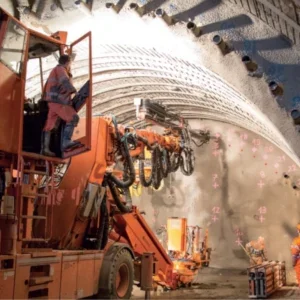Historically, the town of Ipswich has been subjected to extensive seasonal flooding. As in the case of many old towns, Ipswich has a combined system for surface water and sewage, and urban expansion has led to system overload to the point where raw sewage overflows into the River Gipping and the Orwell Estuary are frequent during heavy rainfall. To alleviate these problems and to comply with the EU Urban Wastewater Treatment Directive, which comes into force on January 1 2001, Anglian Water has embarked on a $52.8m major flood relief scheme for the area titled ‘Project Orwell’. Included in the project is the construction of a 4.9km long, 2.4m i.d. flood relief tunnel that will alleviate flooding to areas north and east of central Ipswich, and reduce overflow spill frequency from the network into the River Orwell and River Gipping to a predicted five times a year, reaching a total flood volume of 63 000m3.
Picking the ideal partner
To ensure a successful scheme, Anglian Water (AW) chose a contractor at a very early stage, whose brief was to undertake detailed design, construction and commissioning of the proposed scheme. An original shortlist of six contractors was reduced to two, who were then given six months to develop a detailed design. This was to include: finalising the tunnel route; establishing intermediate shaft locations; connections to the existing sewerage system; and temporary works.
In December 1997, each contractor submitted tenders to AW. The form of contract used was the NEC-ECC Option C target contract with activity schedule. In March 1998, the selection panel of the AW project team selected AMEC Tunnelling, which had recently completed a similar tunnelling project successfully for AW at Clacton-on-Sea in Essex, UK (T&T International, April ’99, p42). AW and AMEC entered into a full partnering agreement for the Project Orwell Tunnel before the start of work in April 1998, which has a scheduled construction period of two years.
The scheme entails the construction of a 4.9km long, 2.4m i.d. TBM driven storm interceptor sewer tunnel, four stormwater holding tanks adjacent to the River Gipping, and 13 shafts that provide access points to the tunnel and connections to the existing sewer. (The tanks were all completed recently in separate contracts.) A number of the shafts are also used as TBM inspection points. Each storage tank has a capacity of 800 cubic metres and the tunnel with shafts has a capacity of 25 000 cubic metres.
The tunnel alignment runs from the north west part of the town, around the north side of the town centre to the outfall structure adjacent to the docks. The tunnelling work is divided into two drives, with Shaft 2 acting as the drive shaft for the TBM on both drives. The first of these drives was the southern 270m long, 2.4m i.d tunnel that connects Shaft 2 to the outfall structure at the docks. Shaft 2 also houses the pumps and weir for overflow discharge to the outfall.
The 9-12m deep tunnel has a straight alignment at a gradient of +1:100 and will transfer emergency storm overflows at Shaft 2 to the outfall for subsequent discharge into the River Orwell. The outfall was constructed to perform two main functions:
- To reduce the velocity of any emergency overflows from the tunnel before discharge into the River Orwell by means of bifurcation through two 2m diameter openings compared to the single existing 2.4m i.d. tunnel
- To allow retrieval of the TBM following drive completion
The second drive, currently under construction, is the North Westerly 4.6km, 2.4m i.d overflow collection/storage tunnel, with a gradient of 1:1000-1:400.The alignment includes curves of 250-600m radius and a number of straight stretches because of the location of the connection works. The tunnel, constructed at depths of 20-50m, will collect and provide storage for storm overflows from various connection works.
After the storm subsides, the diluted sewage will be pumped back into the existing sewerage system for treatment at Cliff Quay Sewage Treatment Works, 1km downstream. An emergency overflow into the Orwell will come into operation during rare storm events. The degree of dilution will be massive to comply with EU limits.
Ipswich is located at the head of the estuary of the River Orwell, 17km from its mouth at Felixstowe. A lack of data on the geology of Suffolk meant a comprehensive investigation was necessary. A F Howland Associates of Norwich undertook a full geological survey of the area for AW, using both rotary and percussive drilling techniques to sink approximately 100 boreholes over a period of 18 months. Cable percussive drilling was used at prospective shaft positions to yield information on the overburden through which the shafts were to be constructed. Rotary boreholes were used to determine the condition of the chalk. Downhole geophysical investigative techniques were also employed.
The survey showed that the local geology comprised three broad units. The area is underlain at depth by Upper Chalk of the Upper Cretaceous, which in turn is overlain by a thick sequence of shallow marine Tertiary sediments capped by London Clay. Finally, the whole area is overlain by glacial deposits and alluvial Terrace Sands and Gravels. The top surface of the chalk has been eroded almost horizontally along the tunnel route, except at either end where the Tertiary has been removed and the chalk incised by glacial valleys.
Ipswich Chalk is weak, white, pure calcium carbonate rich rock consisting of microfossil skeletal material, with a typical strength of 1-5MPa. Ground-water pressure at tunnel depth is 1- 2 bar. The tunnel is being constructed predominantly within the chalk, with about 10m of chalk cover. At either end, it will pass out of the chalk into the glacial valleys, which are backfilled with glacial deposits.
Machinery and methods
Tunnel construction: AMEC Tunnelling is using a Lovat RME115SE mixed face TBM for construction of both drives for the 4.9km tunnel. The 117 tonne (with back-up) machine named ‘Athena’ has the ability to work in full EPB mode, which is necessary to control the groundwater and surface settlement during the excavation cycle. The TBM has 376kW of total available power and 1020 tonne maximum thrust. Spoil is removed via a 500mm diameter, 10m long screw conveyor. Auger and casing are protected by abrasion resistant plating.
For driving the (now completed) 270m connection tunnel from Shaft 2 to the outfall, the cutting head configuration featured a combination of rollers and scrapers. Currently, the 4.6km overflow collection/storage tunnel is being bored with a combination of rippers and scrapers configuration.
To provide access to the TBM cutting head as it crosses the shafts, shaft benching is installed before the machine arrives. This provides support to the shaft lining during TBM breakthrough. Reception and exit eyes are cast into the benching and a void left in the centre for access to the cutting head and for the permanent works. The eyes and the void are filled with a lean sand/cement mortar and a steel cover plate bolted above.
After the TBM has progressed into the shaft, the annulus is filled with a fast acting hydrophillic resin, which seals the TBM/shaft interface and allows the cover plate to be removed and access gained to the cutterhead. Cutting tools are changed as necessary and the cover plate replaced to allow the TBM to leave the shaft. The void between the tunnel lining and the shaft are grouted as the TBM leaves the shaft and the cover plate is removed to allow the permanent works to be completed. Only six cutting tools have been replaced to date, with the remaining tools showing little or no wear.
Lining: The tunnel has a segmental lining designed and manufactured by another AMEC Group company, CV Buchan. The six piece trapezoidal ring incorporates a 14mm taper to assist negotiation of curves and a gasket to ensure the tunnel remains watertight. Grouting operations are facilitated by a handling/grouting socket fitted with a non-return valve cast into the segment.
The annulus between the cut diameter and the extrados of the segmental lining is filled with 5:1 PFA:OPC groutmix, supplied by Reader Grout. The grout is batched on the surface and transferred to the working area by grout cars, which have a facility to agitate at the pit bottom and the TBM to negate the effects of segregation during transportation and to ensure high quality grout material. At the point of injection, sodium silicate is added to the grout mix for acceleration.
Underground transportation: Within the tunnel, material is transported using AMEC-owned battery operated 5 tonne Clayton locos and muck skips. Mucking out is performed by a 50 tonne crawler crane lifting the muck skips to surface and tipping them into a storage bin. Because of the 10m difference in level between the two tunnel drives, a backshunt system between the two drives at Shaft 2 is not possible. A foreshunt system has been adopted by means of which a length of double track with a scissors crossing and a traverser rail within the bottom of the shaft enables the tunnel trains to be serviced efficiently.
Shaft construction: There are 13 shafts along the tunnel route ranging in diameter from 1.8m to 10.7m. All the shafts have been constructed to facilitate connection to the existing sewer network via newly constructed weir chambers intercepting key sewers in strategic locations throughout Ipswich. The 6m shafts allow inspection/replacement of the TBM cutter teeth. Of the 13 shafts, there is one at 10.7m i.d (Shaft 2); six at 6m i.d (shafts 4, 6, 8,11,13,15); one at 4.7m i.d.; five at 1.8m i.d (shafts 7, 9,10,12,14); and an outfall structure.
The one 10.6m i.d and the six 6m i.d shafts were constructed using the jacks and wet caisson technique with Buchan segmental lining. In-situ lining was cast to the outside of the segments as sinking progressed in order to provide stability to the caisson and to help with anti-flotation operations.
The five 1.8m i.d. shafts were constructed by AMEC Piling using the bored pile technique. The drop shafts are offset from the tunnel and had to be connected by a reinforced concrete adit constructed using traditional hand mining techniques through pre-treated ground. The pre-treatment was carried out by AMEC Grouting. The shafts are lined with GRP supplied by Johnson.
Progress to date
Work on the tunnel is carried out from Monday to Friday using a 24h shift cycle. All major maintenance operations are performed at the weekend as necessary. Construction of the 270m outfall connection tunnel began on November 26 1998 following delivery of the TBM. The drive was completed and the TBM recovered from the outfall on February 1 1999. The 4.6km collection/storage tunnel started on February 8 1999 after a week spent refurbishing the TBM. At the time of writing, 3.2km of the second drive are finished and three of the on-line shafts have been crossed. Production rates in excess of 200 linear metres/week have been consistently achieved. The work is currently ahead of schedule and final out-turn costs are anticipated to be within budget.
Related Files
Geological Section
Location Map






